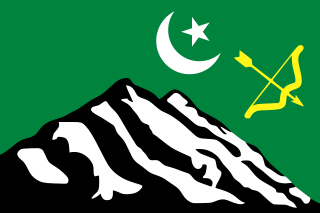
Hunza, also known as Kanjut, was a princely state in the Gilgit Baltistan region of Pakistan. Initially, it functioned as a principality and subsequently became a princely state under a subsidiary alliance with the British India starting in 1892 and continuing until August 1947. For a brief period of three months, it remained unaligned after gaining independence, and then from November 1947 until 1974, it retained its status as a princely state within Pakistan. The territory of Hunza now constitutes the northernmost part of Gilgit-Baltistan, Pakistan.

The Karakoram is a mountain range in the Kashmir region spanning the border of Pakistan, China, and India, with the northwestern extremity of the range extending to Afghanistan and Tajikistan. Most of the Karakoram mountain range falls under the jurisdiction of Gilgit-Baltistan, which is controlled by Pakistan. Its highest peak, K2, is located in Gilgit-Baltistan, Pakistan. It begins in the Wakhan Corridor (Afghanistan) in the west, encompasses the majority of Gilgit-Baltistan, Pakistan and extends into Ladakh and Aksai Chin.
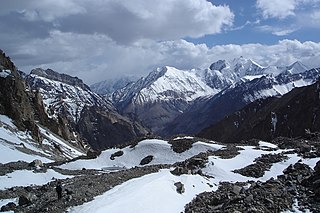
The Pamir Mountains are a range of mountains between Central Asia and South Asia. They are located at a junction with other notable mountains, namely the Tian Shan, Karakoram, Kunlun, Hindu Kush and the Himalaya mountain ranges. They are among the world's highest mountains.
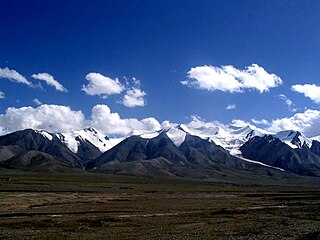
The Kunlun Mountains constitute one of the longest mountain chains in Asia, extending for more than 3,000 kilometres (1,900 mi). In the broadest sense, the chain forms the northern edge of the Tibetan Plateau south of the Tarim Basin. Located in Western China, the Kunlun Mountains have been known as the "Forefather of Mountains" in China.

Hunza River is the principal river within the Hunza region in Gilgit–Baltistan, Pakistan. It is formed by the confluence of the Chapursan and Khunjerab nalas (gorges) which are fed by glaciers. It is also joined by the Gilgit River and the Naltar River, before it flows into the Indus River.

The Karakoram Highway is a 1,300 km (810 mi) national highway which extends from Hasan Abdal in the Punjab province of Pakistan to the Khunjerab Pass in Gilgit-Baltistan, where it crosses into China and becomes China National Highway 314. The highway connects the Pakistani provinces of Punjab and Khyber Pakhtunkhwa plus Gilgit-Baltistan with China's Xinjiang Uyghur Autonomous Region. The highway is a popular tourist attraction and is one of the highest paved roads in the world, passing through the Karakoram mountain range, at 36°51′00″N75°25′40″E at maximum elevation of 4,714 m (15,466 ft) near Khunjerab Pass. Due to its high elevation and the difficult conditions under which it was constructed, it is often referred to as the Eighth Wonder of the World. The highway is also a part of the Asian Highway AH4.

The Hunza Valley is a mountainous valley in the northern part of the Gilgit-Baltistan region of Pakistan.

Chinese Pamiris are ethnic Pamiris who live in the Pamir Mountains of Tashkurgan Tajik Autonomous County, in Xinjiang, China. They are one of the 56 ethnic groups officially recognized by the Chinese government. Most Chinese Pamiris speak an Eastern Iranian language; the vast majority speak Sarikoli while a minority speak Wakhi.

Karanasa is an Old World genus of subfamily Satyrinae.

The Hunza-Nagar Campaign was fought in 1891 by troops serving as military personnel of the British Raj against the princely states of Hunza and Nagar in the Gilgit Agency. It is also known in Pakistan as the Anglo-Brusho War or Jangir-e-Lae.
Parnassius kiritshenkoi is a high-altitude butterfly which is found only in the eastern Pamir Mountains. It is a member of the snow Apollo genus Parnassius of the swallowtail family, Papilionidae. The species was first described by Andrey Avinoff in 1910 as a subspecies of Parnassius delphius.

Taghdumbash Pamir or Taxkorgan Nature Reserve is a pamir or high valley in the south west of Tashkurgan Tajik Autonomous County, in Xinjiang, China. It lies to the west of the Karakoram Highway. It is inhabited by Wakhi, Kirghiz and Sarikolis animal herders, who graze yaks and other animals on the grasslands of the Pamir.
The Hunza–Nagar District is a former district of Gilgit–Baltistan in Pakistan. In July 2015, the district was divided into two separate districts, namely Hunza District and Nagar District.

Lepidopterology is a branch of entomology concerning the scientific study of moths and the two superfamilies of butterflies. Someone who studies in this field is a lepidopterist or, archaically, an aurelian.

The Pamir-Alay is a mountain system in Tajikistan, Kyrgyzstan and Uzbekistan, encompassing four main mountain ranges extending west from the Tian Shan Mountains, and located north of the main range of Pamir. They are variously considered part of the Tian Shan, of the Pamir, or a separate mountain system. The term "Pamiro-Alay" is also used to refer to the mountain region encompassing the Pamir, the Pamir-Alay proper and the Tajik Depression.

Karanasa modesta is a butterfly of the family Nymphalidae. It is found in India.
Karanasa moorei is a butterfly of the family Nymphalidae. It is found in north-western India and Afghanistan.
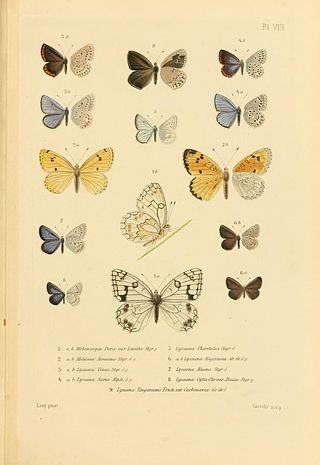
Agriades pheretiades, the Tien Shan blue, is a Palearctic butterfly of the family Lycaenidae.
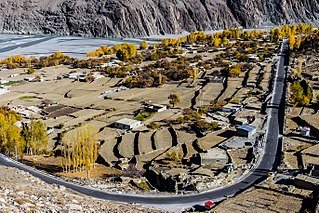
Hunza District is a district of Pakistan-administered Gilgit-Baltistan in the disputed Kashmir region. It is one of the 14 districts of the Gilgit-Baltistan region. It was established in 2015 by the division of the Hunza–Nagar District in accordance with a government decision to establish more administrative units in Gilgit-Baltistan. The district headquarters is the town of Karimabad.
















